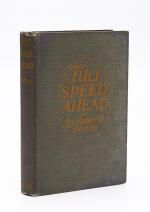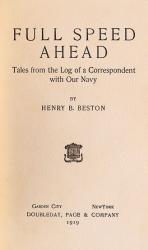Beston, Full Speed Ahead. Tales from the Log of a Correspondent with Our Navy.
Full Speed Ahead. Tales from the Log of a Correspondent with Our Navy. [Inscribed Association copy from Henry B. Beston to Admiral William Sowden Sims – with original typescript in an envelope that is tipped into the pastedown / It is a typescript of a letter that was written during Beston’s time as editor at the magazine “The Living Age” (an offshoot of ‘Atlantic Monthly’) and stunningly also reflects on Beston’s classmate, Theodore Roosevelt, whom he obviously gave a copy of this book and according to Beston’s letter to Sims, Theodore Roosevelt and his children confirming that they enjoyed it. The letter reveals that Beston sends this book as a “thank you” to Admiral Sims for his time as war correspondent under Sims’ command during World War I. The typescript of the letter must be seen as an extension to Beston’s Preface in the book in which he writes: “And no acknowledgment, no matter how studied or courtly, its phrasing, can express what I owe to Admiral Sims for the friendliness of my reception, for his care that i be shown all the Navy’s activities, and for his constant and kindly effort to advance my work in every possible way”].
First Edition. New York, Doubleday, 1919. Octavo. XIII, 254 pages. Original Hardcover in protective Mylar. Very Scarce [OCLC locates only 1 copy]. Very good + condition with only minor signs of external wear. The definitive, signed and inscribed association copy by Henry B. Beston to Admiral William Sowden Sims and also with a letter typescript to Admiral William Sowden Sims. The inscription reads: “To Admiral Sims with every grateful good wish of the author – Henry Beston Sheahan – 1919”.
The included original typescript from Beston to Sims reads:
″Dear Admiral Sims,
Perhaps as you open this book you will wonder what brings a volume of new fairy tales to your desk and when you find my name on the title page, you will wonder still more why a sometime war correspondent who went to sea with the fleets under your command should now turn up with a galleon from Fairyland. It all comes from the fact that the author of these wonder stories is something of a sailor himself and wishes to present his new book to the junior Simses with the very best compliments of the season. The book has much to tell of fairy seas and ships.
But they need not be feared by grown ups with a sense of humor. My friend and classmate, Lt. Col. Theodore Roosevelt wrote me that he had enjoyed them as well as the junior Roosevelts…….[…].
With all good wishes I am sir
Faithfully yours
Henry B. Beston
(signed) Henry Beston Sheahan
Dec. 8, 1919 (Mrs. Sims has the original of this letter)″
______________________________________________________________________________________________
Henry Beston (June 1, 1888 – April 15, 1968) was an American writer and naturalist, best known as the author of “The Outermost House”, written in 1928. Born Henry Beston Sheahan in Boston, he grew up in Quincy, Massachusetts with his parents, Dr. Joseph Sheahan and Marie Louise (Maurice) Beston Sheahan, and brother George. Beston attended Adams Academy in Quincy before earning his B.A. (1909) and M.A. (1911) from Harvard College. After leaving Harvard, Beston took up teaching at the University of Lyon. In 1914 he returned to Harvard as an English department assistant. Beston joined the French army in 1915 and served as an ambulance driver. His service in le Bois le Pretre and at the Battle of Verdun was described in his first book, A Volunteer Poilu. In 1918, Beston became a press representative for the U.S. Navy. Highlights from this period include being the only American correspondent to travel with the British Grand Fleet and to be aboard an American destroyer during combat engagement and sinking. His second book of journalistic work, “Full Speed Ahead”, described these experiences. (Wikipedia).
___________________________________
William Sowden Sims (October 15, 1858 – September 28, 1936) was an admiral in the United States Navy who fought during the late 19th and early 20th centuries to modernize the navy. During World War I he commanded all United States naval forces operating in Europe. He also served twice as president of the Naval War College.
Sims was born to American parents Alfred William (1826–1895) and Adelaide (née Sowden; b. 1835) living in Port Hope, Ontario, Canada. He graduated from the United States Naval Academy in 1880, the beginnings of an era of naval reform and greater professionalization. Commodore Stephen B. Luce founded the Naval War College in Newport, Rhode Island in 1884, to be the service’s professional school. During the same era, Naval War College instructor Captain Alfred Thayer Mahan was writing influential books on naval strategy and sea power.
In March 1897, shortly after his promotion to lieutenant, Sims was assigned as the military attaché to Paris and St. Petersburg. In this position he became aware of naval technology developments in Europe as well gaining familiarity with European politics which would greatly assist him during World War I. He was in this assignment during the Spanish–American War during which Sims was able to use his diplomatic connections to gain information on Spain and its high-ranking officials.
As a young officer, Sims sought to reform naval gunnery by improving target practice. His superiors resisted his suggestions, failing to see the necessity. He was also hindered by his low rank. In 1902, Sims wrote directly to President Theodore Roosevelt. The president, who had previously served as Assistant Secretary of the Navy, was intrigued by Sims’ ideas and made him the Navy’s Inspector of Naval Gunnery on November 5, 1902, shortly after which Sims was promoted to lieutenant commander. He was promoted to commander in 1907.
From 1911 to 1912, Sims attended the Naval War College. Promoted to captain in 1911, he became Commander, Atlantic Destroyer Flotilla in July 1913. On March 11, 1916, Sims became the first captain of the battleship USS Nevada. Nevada was the largest, most modern and most powerful ship in the U.S. Navy at that time. His selection as her captain shows the esteem in which he was held in the Navy.
Shortly before the United States entered World War I, then Rear Admiral Sims was assigned as the president of the Naval War College in Newport, Rhode Island in February 1917. Just before the U.S. entered the war, the Wilson administration sent him to London as the senior naval representative. After the U.S. entry in April 1917, Sims was given command over U.S. naval forces operating from Britain. He received a temporary promotion to vice admiral in May 1917.
The major threat he faced was a highly effective German submarine campaign against freighters bringing vital food and munitions to the Allies. The combined Anglo-American naval war against U-boats in the western approaches to the British Isles in 1917–18 was a success due to ability of Sims to work smoothly with his British counterpart, Admiral Sir Lewis Bayly.
Sims believed the Navy Department in Washington, which was effectively headed by Assistant Secretary Franklin D. Roosevelt, was failing to provide him with sufficient authority, information, autonomy, manpower, and naval forces.
He ended the war as a vice admiral, in command of all U.S. naval forces operating in Europe. Shortly after the Armistice, Sims was promoted to temporary admiral in December 1918 but reverted to his permanent rank of rear admiral in April 1919 when he was assigned as president of the Naval War College.
In 1919 after the war ended in Allied victory, Sims publicly attacked the deficiencies of American naval strategy, tactics, policy, and administration. He charged the failures had cost the Allies 2,500,000 tons of supplies, thereby prolonging the war by six months. He estimated the delay had raised the cost of the war to the Allies by $15 billion, and that it led to the unnecessary loss of 500,000 lives. Secretary of the Navy Josephus Daniels was more of a politician than a naval strategist, but he ably countered the accusations. He pointed to Sims’ anglophilism and said his vantage point in London was too narrow to assess accurately the overall war effort by the U.S. Navy. Daniels cited prewar naval preparations and strategy proposals made by other American leaders during the war to disprove Sims’ charges.
Despite the public acrimony, Sims emerged with his reputation unharmed and served a second tour as president of the Naval War College (1919–1922). It was during his time as the Naval War College that he wrote and published his book The Victory at Sea which describes his experiences in World War I. In 1921 The Victory at Sea won the Pulitzer Prize for History. Sims is, possibly, the only career naval officer to win a Pulitzer Prize. (Rear Admiral Samuel E. Morison won two Pulitzer Prizes but only served nine years in the Naval Reserve.) Sims retired from the Navy in October 1922, having reached the mandatory retirement age of 64. In retirement he lived at 73 Catherine Street in Newport, Rhode Island. He appeared on the cover of the October 26, 1925 issue of Time magazine and was the subject of a feature article. He was promoted to full admiral on the retired list in 1930.
Admiral Sims died in Boston, Massachusetts, in 1936 at the age of 77. He is buried in Arlington National Cemetery. (Wikipedia)
- Keywords: American History · American History – Rare · American Literature · American Literature – Rare · American Military History · Association Copies · Association Copy · Autograph – Rare · Catalogue Twenty-Three – Maritime History & Travel · Conservation · Conservation Movement · Conservation Movement – Rare · Henry Beston (Naturalist) · Inscribed · Manuscript / Autograph – Rare · Maritime History – Rare · Naturalist · Navy · Provenance · Signed · Theodore Roosevelt · Typed Letter (Typescript) · WCBF Highlight · William Sowden Sims (Admiral Sims)
- Language: English
- Inventory Number: 28662AB
EUR 1.400,--
© 2024 Inanna Rare Books Ltd. | Powered by HESCOM-Software




















